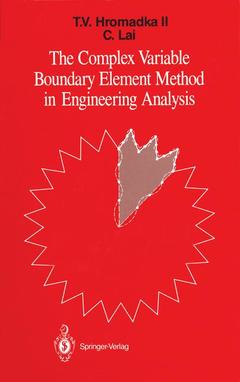The Complex Variable Boundary Element Method in Engineering Analysis, Softcover reprint of the original 1st ed. 1987
Langue : Anglais
Auteurs : Hromadka Theodore V., Lai Chintu

The Complex Variable Boundary Element Method (CVBEM) has emerged as a new and effective modeling method in the field of computational mechanics and hydraulics. The CVBEM is a generalization of the Cauchy integral formula into a boundary integral equation method. The model ing approach by boundary integration, the use of complex variables for two-dimensional potential problems, and the adaptability to now-popular microcomputers are among the factors that make this technique easy to learn, simple to operate, practical for modeling, and efficient in simulating various physical processes. Many of the CVBEM concepts and notions may be derived from the Analytic Function Method (AFM) presented in van der Veer (1978). The AFM served as the starting point for the generalization of the CVBEM theory which was developed during the first author's research engagement (1979 through 1981) at the University of California, Irvine. The growth and expansion of the CVBEM were subsequently nurtured at the U. S. Geological Survey, where keen interest and much activity in numerical modeling and computational mechanics-and-hydraulics are prevalent. Inclusion of the CVBEM research program in Survey's computational-hydraulics projects, brings the modeling researcher more uniform aspects of numerical mathematics in engineering and scientific problems, not to mention its (CVBEM) practicality and usefulness in the hydrologic investigations. This book is intended to introduce the CVBEM to engineers and scientists with its basic theory, underlying mathematics, computer algorithm, error analysis schemes, model adjustment procedures, and application examples.
1 Basic Principles and Mathematical Models of Engineering Mechanics Problems.- 1.0 Introduction.- 1.1 Ideal-Fluid Flow.- 1.2 Porous Media Flow.- 1.3 Fickian Diffusion.- 1.4 Heat Flow.- 1.5 Elasticity Problems.- 1.6 Use of Laplace Equation.- 1.7 Mathematical Modeling.- 1.8 Computational Mechanics and Hydraulics.- 1.9 Modeling of Potential Problems.- 2 A Review of Complex Variable Theory.- 2.0 Introduction.- 2.1 Preliminary Definitions.- 2.2 Polar Forms of Complex Numbers.- 2.3 Limits and Continuity.- 2.4 Derivatives: Analytic Functions.- 2.5 The Cauchy-Riemann Equations and Harmonic Functions.- 2.6 Complex Line Integration.- 2.7 Cauchy’s Integral Theorem.- 2.8 The Cauchy Integral Formula.- 2.9 Taylor Series.- 2.10 Program I: A Complex Polynomial Approximation Method.- 2.11 Complex Variables and Two-Dimensional Fluid Flow.- 3 Mathematical Development of The Complex Variable Boundary Element Method (CVBEM).- 3.0 Introduction.- 3.1 Basic Definitions.- 3.2 Characteristics of the Linear Global Trial Function.- 3.3 The H1 Approximation Function.- 3.4 Higher Order HK Approximation Functions.- 3.5 Using ? or ? Functions as Boundary Conditions.- 4 A Computer Algorithm for the Complex Variable Boundary Element Method.- 4.0 Introduction.- 4.1 A Complex Variable Boundary Element Approximation Model.- 4.2 The Analytic Function Defined by the Approximation $$\hat w\left( z \right)$$.- 4.3 Program 2: A Linear Basis Function Approximation $$\hat w\left( z \right)$$.- 4.4 A Constant Boundary Element Method.- 4.5 Summary of Basic CVBEM Modeling Algorithm.- 5 Reducing CVBEM Approximation Error.- 5.0 Introduction.- 5.1 Application of the CVBEM to the Unit Circle.- 5.2 Approximation Error from the CVBEM.- 5.3 A CVBEM Modeling Strategy to Reduce Approximation Error.- 5.4 A Modified CVBEM Numerical Model.- 5.5 Program 3: A Modified CVBEM Numerical Model.- 5.6 Determining Some Useful Error Bounds for the CVBEM.- 6 The Approximative Boundary.- 6.0 Introduction.- 6.1 Expansion of the HK Approximation Function.- 6.2 Upper Half Plane Boundary Value Problems.- 6.3 The Approximative Boundary for Error Analysis.- 6.4 Program 4: Analytic Continuation Model.- 6.5 Locating Additional Nodal Points on ?.- 7 CVBEM Modeling Techniques.- 7.0 Introduction.- 7.1 Sources and Sinks.- 7.2 Program 5: Source and Sink Model.- 7.3 Regional Inhomogeneity.- 7.4 Program 6: Nonhomogeneous Domain.- 7.5 The Poisson Equation.- 7.6 Computer-Aided-Analysis and the CVBEM.- 8 CVBEM Applications.- 8.0 Introduction.- 8.1 Modeling Nonuniform St. Venant Torsion.- 8.2 Numerical Calibration of Domain Models.- 8.3 Modeling Steady State, Advective Contaminant Transport.- 8.4 A Simple Model of Soil Water Phase Change.- 8.5 Modeling Two-Dimensional Steady State Soil Freezing Fronts.- References.- List of Symbols.- Mathematical Notations.
Date de parution : 12-2011
Ouvrage de 389 p.
15.5x23.5 cm
Disponible chez l'éditeur (délai d'approvisionnement : 15 jours).
Prix indicatif 105,49 €
Ajouter au panierThème de The Complex Variable Boundary Element Method in... :
© 2024 LAVOISIER S.A.S.
